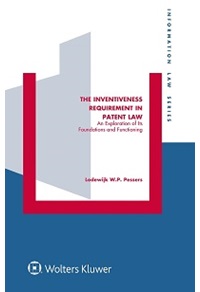 Wolters Kluwer released a new title last week in the Information Law Series: The Inventiveness Requirement in Patent Law by Lodewijk Pessers. Pessers recently received his Ph.D. in this subject. We asked the author to briefly describe the book’s contents.
Wolters Kluwer released a new title last week in the Information Law Series: The Inventiveness Requirement in Patent Law by Lodewijk Pessers. Pessers recently received his Ph.D. in this subject. We asked the author to briefly describe the book’s contents.
By Lodewijk Pessers
‘The Inventiveness Requirement in Patent Law’ tries to answer the question of how the inventiveness requirement has evolved over time, that is, from the very first moment that we can distinguish its contours up to the present day. In doing so, it focuses on three aspects in particular: what are the historical phases that can be discerned in the requirement’s evolution? What are the socio-economic and political forces that have determined or influenced its course? And how can similarities and dissimilarities between the jurisdictions under examination (i.e. the United States, the United Kingdom, Germany and the Netherlands) be explained?
The book is divided into two parts. The first describes the evolution in its first three phases: the medieval, the mercantilist and the pre-modern phases. The last is dedicated to the modern phase and devotes particular attention to two different ‘schools’ that developed in the 19th century and which continue to be relevant for the doctrine’s direction, even today. The first of these, dubbed the qualitative school, is based on the idea that patents should reward the traditional (others would say ‘archetypical’) inventor. The criterion of inventiveness, in this view, is meant to distinguish between the routine products of workmen and the ingenious, extraordinary output of inventors. In this tradition concepts such as ‘genius’, ‘ingenuity’, ‘obviousness in the eyes of the mechanic’ and ‘creativity’ often appear. The patent system’s main beneficiary is seen as an individual who, gifted with his exceptional qualities, importantly contributes to the advance of technology. The quantitative tradition, on the other hand, is leery of such lofty images. Instead, it prefers to represent innovation as an incremental process that typically takes places in a corporate or industrial context. Inventiveness, in this view, lies in new or useful results or, more simply, in a certain advance over the prior art. As a result, the standard of inventiveness is believed to require only a minimal contribution beyond novelty. Notable points of attention within this school of thought are ‘hindsight reasoning’ and avoiding this reasoning, and what are known as secondary considerations. It also tends to present itself as being more objective than the qualitative approach. It will be argued that the two schools have gradually merged into a hybrid approach that is rather qualitative in its appearance, but quantitative in its application.
As increasing numbers of patents are being issued worldwide, the concept of inventiveness (translated into criteria as ‘non-obviousness’ and ‘inventive step’) has received more and more attention. In current debates, the question is often raised whether the requirement of inventiveness is still balanced and capable of functioning as an adequate ‘gate-keeper’. This book provides a broad and historical perspective that might be helpful in times of intensifying self-examination: are we moving in the right direction or are modern patentability thresholds becoming (dangerously) low? ‘The Inventiveness Requirement in Patent Law’ tries to lay the groundwork for further and more in-depth discussions about the current standard/standards of inventiveness.
________________________
To make sure you do not miss out on regular updates from the Kluwer Patent Blog, please subscribe here.


